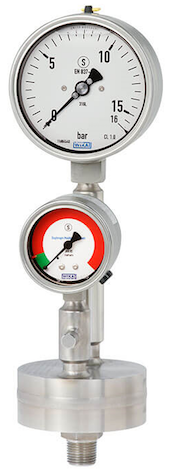Alkylation units use very strong catalysts, such as hydrofluoric acid, to produce the components for high-octane gasoline. That’s why refineries need process gauges and other pressure instruments that can withstand highly corrosive environments.
Petroleum refineries rely on alkylation units to produce higher-grade and, therefore, higher-value products. After a fluidized catalytic cracking (FCC) unit transforms heavy feedstock into short hydrocarbon chains, an alkylation unit further converts the molecules into alkylates, a higher-octane component of gasoline.
Hydrofluoric Acid: Effective and Hazardous
The alkylation process requires a strong catalyst, the most common of which are sulfuric acid and hydrofluoric acid (HF). The advantage of a hydrofluoric acid alkylation unit (HFAU) is that it uses less catalyst, processes a wider range of feedstocks, and produces higher-octane components than a sulfuric acid alkylation unit (SAAU).
Needless to say, HF is highly hazardous. It can burn the lungs when inhaled and cause severe burns when it touches the skin. To keep technicians safe, an HF alkylation unit must constantly monitor the process to prevent vapor releases, fugitive emissions, and leaks.
Anti-corrosive Instruments for Alkylation Units
To properly monitor processes in an HFAU, the instruments themselves must be made of corrosion-resistant materials. WIKA has developed an All-Welded System(AWS) specifically for alkylation units that use hydrofluoric acid.
In these 4.5-inch XSEL® process gauges, the Bourdon tube and all wetted and non-wetted diaphragm seal parts are made of Monel® 400. The diaphragm seal is back-welded to a process gauge to eliminate potential leak paths. An InSight ™ Glow dial face improves visibility in low-light areas. The system comes in a yellow or red thermoplastic case to differentiate it from other instrumentation not in contact with HF.
For added protection, the seal can be coated with an acid detecting paint that turns from yellow to red when there is a leak. Both the dry and the liquid-filled versions support EPA requirements for dual containment.
Extra Protection for Alkylation Units

Model DMS34
diaphragm monitoring system with threaded connection
For an additional layer of safety, WIKA offers a Diaphragm Monitoring System(DMS). This patented design features two diaphragm seals with a vacuum in between. A pressure transmitter, switch, or gauge monitors this vacuum. If the primary seal is breached, the DMS gives a visual, acoustic, or electrical warning that the vacuum is compromised. The still-intact secondary diaphragm prevents the release of the hazardous media into the environment, ensuring operator and plant safety.
The DMS can be mounted directly into the process or via a capillary line. A cooling tower can be added between the diaphragm and the measuring instrument.
Cheaper process gauges can adequately monitor pressure in an HF alkylation unit. But in the longer run, those instruments will corrode and become a source of dangerous emissions and leaks. WIKA’s All-Welded Systems for hydrofluoric acid and the DMS’s double-diaphragm design provide the safety and reliability modern refineries need. Contact our petrochemical specialists to find out more about WIKA’s high-quality instruments and customer service.


Hello wika.us webmaster, Your posts are always well-timed and relevant.